Brazilian Feijoada is a black bean and pork stew that Brazilians often serve topped with farofa, toasted cassava flour. Many call this comfort food the national dish of Brazil.
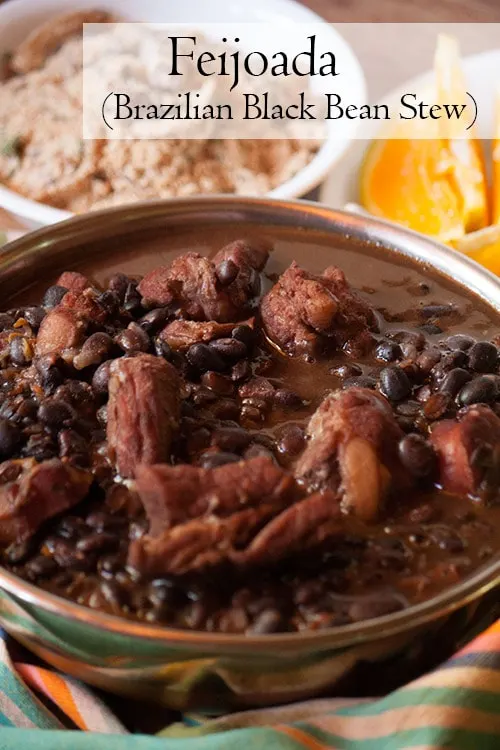
Feijoada, a popular Brazilian dish, owes its name to its main ingredient, black beans (feijão). It is a rich stew traditionally made from different parts of the pig, such as feet, ears, and bacon, as well as other smoked meats. (But don’t worry, I have some substitutions for you if you’re not up to cooking with pig ears and feet!)
Brazilian Cuisine
Brazilian cuisine is very regionalized, each region has its own typical dishes. This is the result of a mixture of different European, Indigenous, and African ingredients and influences.
In the northeast region of Brazil, there is a great influence from African cuisine.
However, in the northern region, there is a greater influence from the Natives, where the use of cassava and fish come into play in many of their dishes.
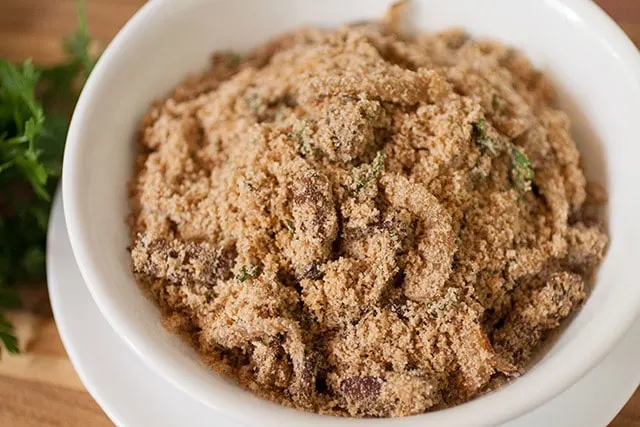
In the southeast region of Brazil, there are diverse dishes linked to the Bandeirantes (bandits) that include ingredients like corn, beans, and pork.
In the southern region, Italian cuisine has a great influence on dishes such as polenta and pizza. And we also see the influence of German cuisine.
History of Feijoada
Some historians say that African slaves created feijoada (pronounced fay-jwa-da). After feasts given by the owners of the plantations, the slaves would pick up the leftovers and mix them with black beans, making a new stew.
This new dish they served with farofa (fried cassava flour with bacon) and orange slices.
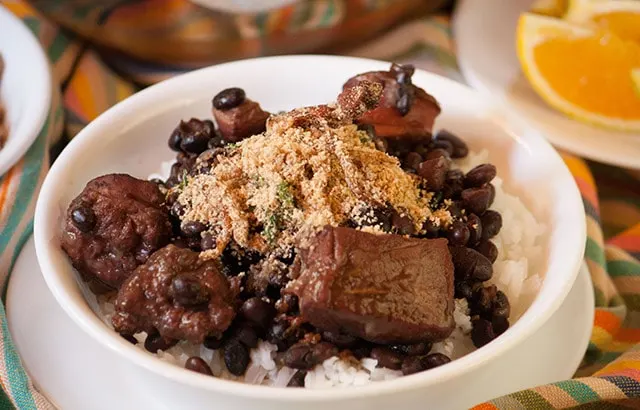
Other historians say that a similar dish was consumed in the north of Portugal, where its main ingredients were white or red beans and pork.
Whichever the story is, feijoada is a symbol of the fusion within Brazilian gastronomic culture. It is a Brazilian icon.
When to Eat Feijoada
Brazilians usually eat feijoada on Wednesdays and Saturdays when restaurants traditionally offer it on their menus and families prepare it in social gatherings.
All social classes eat feijoada since it is such a low-cost dish.
In some parts of Brazil, they only serve feijoada during the winter months. However, in Rio de Janeiro this dish is served all year round.
How to Serve Brazilian Feijoada
If you are up for a challenge, serve a feijoada completa (complete feijoada) meal.
Feijoada completa starts with fried cassava as an appetizer.
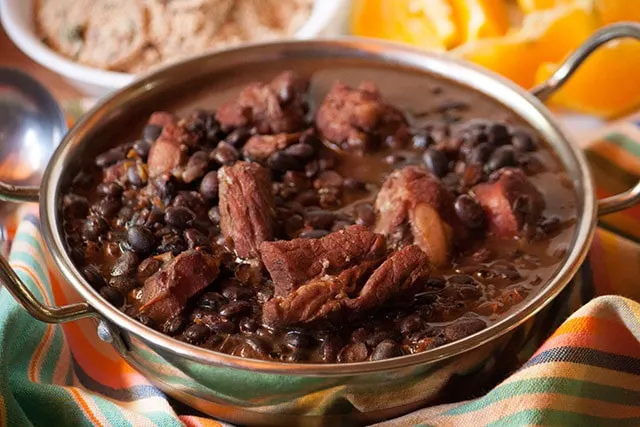
Then, the main dish, is feijoada, white rice, fried plantains, farofa (fried cassava flour with bacon), and sliced oranges.
Drinks can be fresh juice, caipirinhas, or beer.
To finish up, serve some fruit compote or this simple and delicious Romeu e Julieta.
What Goes into Feijoada?
Traditional feijoada is made with pig’s ear, feet, and snout along with Brazilian sausage.
For our recipe, we are using bacon, pork ribs, and 2 kinds of sausages, Mexican chorizo, and linguica.
A note on the sausage: Mexican chorizo is the most widely-used substitute for Brazilian sausage (which is quite hard to find outside of Brazil). But when I’ve tested it, it still doesn’t quite give the same flavor to this stew that you would find in a truly authentic Brazilian feijoada.
The chorizo is very oily as well. I do recommend you cook it first in a separate pan, drain the oil, and then add the cooked sausage with the rest of the ingredients.
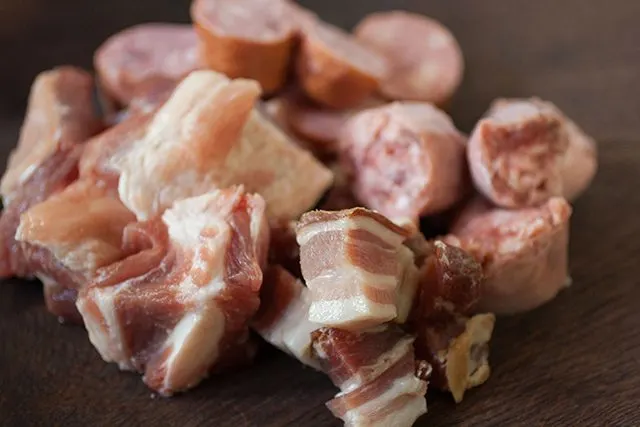
Our Feijoada Recipe
This is such a great dish for big groups. It is easy to make and very cheap.
It is very important that the beans are soaked overnight. You can very well use canned beans too.
You can also make feijoada in a slow cooker. After sauteing the vegetables and browning the meat, add it to the slow cooker and cook on low for 10 hours.
While making farofa to serve with feijoada is an extra step, it is so worth it. I definitely recommend you serve this feijoada with farofa.
Any leftovers, I like to freeze in individual portions for easy reheating. The stew keeps well in the freezer for up to 3 months.
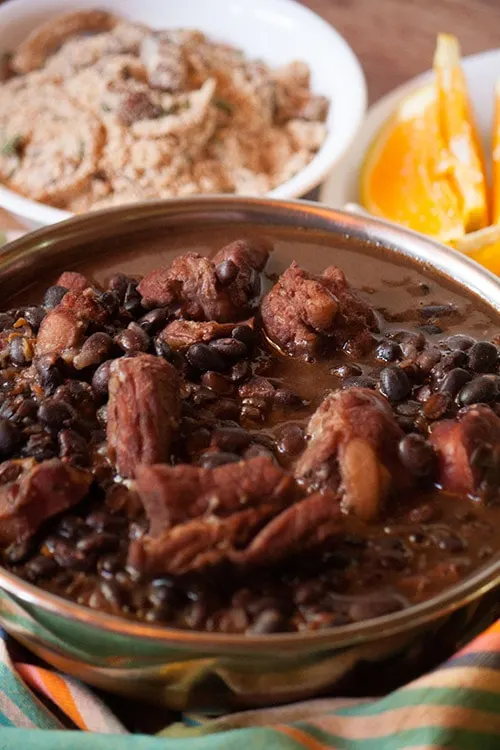
Brazilian Feijoada (Black Bean Stew)

Brazilian Feijoada is a black bean and pork stew that is often served with farofa, toasted cassava flour.
**Since we're using dried beans, you will need to soak them overnight before cooking the stew. **
Ingredients
- 1 pound dry black beans (soaked overnight)*
- 1 tablespoon olive oil
- 4 ounces slab bacon (rind removed), diced
- 1 pound pork ribs, cut into individual ribs
- 2 Mexican chorizo sausages (roughly 11 oz each), sliced**
- 1 smoked sausage (roughly 7 oz), such as linguica or kielbasa, sliced
- 1 large onion, chopped
- 4 cloves garlic, minced
- 3 tomatoes, diced
- 1 teaspoon salt
- 1 teaspoon ground black pepper
- 3 bay leaves
- water
- white rice (for serving)
- farofa (for serving)
Instructions
- In a large bowl with water, soak beans overnight.
- When you are ready to make your stew, in a large heavy-bottom soup pot, over medium heat, add the oil and bacon. Cook until crisp and transfer to a plate.
- Use the same saucepan to brown ribs and sausages in batches. (You will want to be sure to cook the sliced Mexican chorizo on its own, as it can be very greasy. Drain the grease before continuing.) Set each aside as cooked.
- If needed, add more oil to the pan. On medium-high, sauté onion, and garlic until soft and translucent, about 5 minutes. Add tomatoes and cook for another 3 minutes.
- Drain and rinse the soaked beans. Add them to the pot along with the ribs, bacon, sausages, salt, pepper, and bay leaf. Cover with water (about 8 cups).
- Bring the mixture to a boil and reduce the heat to low. Cover and let it cook for 2 to 2 and a half hours, or until the beans are soft.
- If the stew is too liquidy, uncover the saucepan and continue to cook for another 20 minutes to allow some of the liquid to evaporate.
- Serve with white rice and sprinkle some farofa on top.
Notes
* 1 pound dry beans = 2 cups dry beans = 6 cups cooked beans (Feel free to substitute 6 cups of drained, canned beans if desired. However, if substituting canned beans, you will need to reduce the amount of water to 3-4 cups since the beans will not absorb much water as they cook.)
** If you can only find 9 oz chorizo sausages, 2 of that size will work just fine.
Nutrition Information:
Yield:
10Serving Size:
1Amount Per Serving: Calories: 620
If you liked this recipe, here are some similar dishes you may enjoy!

Lizet is Bolivian and lives in Paraguay. Through friends and travel she has developed her love of food. From Africa to Asia, Europe to the Americas, there is always something new to try when you come to dinner. You can find more of Lizet’s tasty creations on her website ChipaByTheDozen.com. You can also find her on Instagram and Facebook.








Leonardo
Thursday 3rd of August 2023
The recipe for Brazilian Feijoada call for Carne Seca, which translates into Dry Beef (salted dry beef, to be more precise), that gives a specific taste to the beans, and is immediately noticed if the stew does not have it. For the readers living in the United States and Canada, there is a company making authentic Carne Seca with the same flavour and texture of the product made in Brazil, however it is made in Canada, with Canadian beef, approved by both CFIA and USDA. Company is called LEAD FOODS, and product can be bought online through their website (they ship by regular mail to any postal code in Canada and USA, as product is shelf-stable), or on amazon.com and amazon.ca. For the fortunate ones that live in Canada, same company sell the "Feijoada Kit" with all the meats you need to make Feijoada at home, in about 40 minutes. They make Carne Seca, Paio smoked sausage and Calabresa smoked sausage. As a Brazilian myself, born and raised in the Northeast of Brazil, and now living in Canada, I have tried all of them. Go for it!
Leonardo Barbosa
Tuesday 26th of September 2023
@Sarah - Curious Cuisiniere, my pleasure! Thanks for the recipe!
Leonardo Barbosa
Tuesday 26th of September 2023
@Courtney, first of all, you need to de-salt the carne Seca, by either soaking it overnight in fresh water(and exchanging the water at least 3 times e.g. 5pm, 10pm, 7am), or you can boil it for 20 minutes in water (at least 4 litres in a sauce pot). I myself prefer soaking, as it preserves fat and flavours. Remember to discard used water. After de-salted, add it on step 5.
Courtney
Saturday 26th of August 2023
@Leonardo, I've purchased the Carne Seca on your recommendation. How would you incorporate it in the recipe above?
Sarah - Curious Cuisiniere
Monday 7th of August 2023
Thank you for sharing Leonardo!
Marianne
Sunday 16th of April 2023
The ingredients remind me so much of cassoulet, which I adore! Looking forward to making this!
Sarah - Curious Cuisiniere
Saturday 29th of April 2023
Very true! Such an interesting connection. We hope you enjoy the feijoada!
Jessica
Sunday 26th of February 2023
Would really appreciate if you had weight or cup measurements. It’s hard for my to judge if my 1 sausauge link or kielbasa coil is the same quantity you meant for the recipe. Hoping I guessed correctly and mine turns out ok!
Sarah - Curious Cuisiniere
Wednesday 1st of March 2023
Hi Jessica. We hope your feijoada turned out well. We will work on getting some weights up here for these.
Greg
Friday 17th of February 2023
Cajun boudin sausage is very close to Brazilian/Portuguese linguiça.
To cook the collard greens you will want to remove the vein, roll up the leaves, then slice the roll in thin slices so you have thin strips to fry up. I fry them up in bacon grease.
Sarah - Curious Cuisiniere
Saturday 18th of February 2023
Thanks for sharing Greg.
Kenneth
Monday 13th of February 2023
Used Dried beans and 4 cups of water was easily enough. I'm glad I read the other comments. also I would like to know if I should strip the meat off the ribs and discard the bones or serve the meal with the bones? Also the collard greens fried with what? vegetable oil? Thinly sliced oranges on top or on a seperate plate ? Really tasty and my Brazilian wife will be pleased I hope :-)
Lizet
Tuesday 14th of February 2023
@Kenneth, the collard green are sauted with oil, a little bit of garlic, salt, and pepper. Thinly sliced oranges and collard greens go on the plate as well, just to the side.